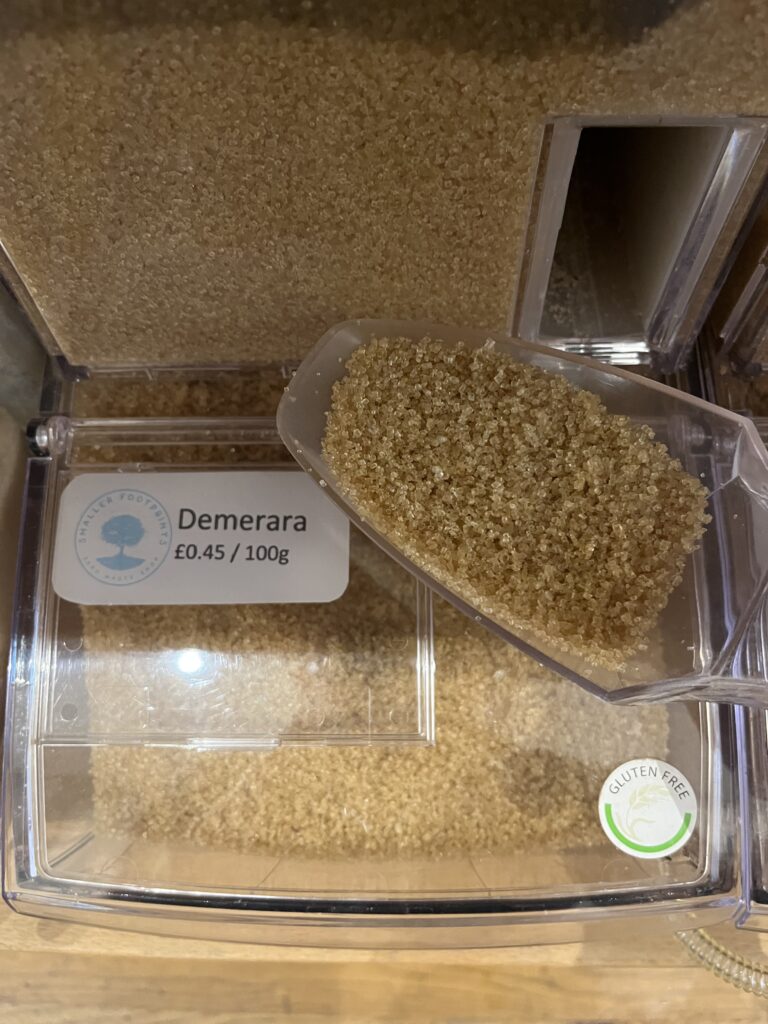In light of our recent blog post about the origins of Demerara sugar, Lewis has further explored the differences between types of sugar produced from sugar cane or beet, as well as from other sources of sweeteners and sugar.
We hope that this can provide you with some knowledge about the sugar we stock in store and some that you might not have come across/cooked with.
Sugars from sugar cane or sugar beet



Molasses – This is the dark sticky substance that comes out of sugarcane or sugar beet when processed. It is also known as black treacle and has a strong bitter taste. This is the least refined form of sugar. This is used to make dark brown and muscovado sugar in the refining process and is also used in the rum making industry.

Dark Muscovado – Dark muscovado is a refined version of molasses. Molasses has been crystalised to form small dark crystals that still stick together somewhat due to there still being molasses present. This gives the sugar a distinct caramel and rich taste. The name muscovado comes from a corruption of the Portugese term açúcar mascavado (unrefined sugar) – mascavado meaning unrefined.

Light Muscovado – Further refine dark muscovado and you’ll get light muscovado. This retains some of the caramel taste as the darker version but it isn’t as strong.

Demerara – Demerara has been further refined and crystalised to form larger and lighter sugar crystals. While still having a caramel taste this type of sugar is sweeter and less bitter than the other two. You will often find this type of sugar served with coffee.

White sugar – Refining Demerara sugar removes more molasses from the sugar giving us the white sugar we most commonly associate with the product. Here we get into the white sugars that while cannot be refined any further, instead they are sold in different forms. Standard white sugar is granulated; this is what you would use as sweeteners or cubed.

Caster sugar – A finer form of granulated sugar which is usually used in baking. The term comes from it being placed in casters (shakers) for people to sprinkle sugar over cakes or other food items, as it is still used for today. Its finer texture allows for it to make smooth batters easily for cakes and other baked items.
Icing sugar – An even finer form of white sugar, often used in patisseries or for icing. Icing sugar is a fine powder, hence its alternative name powdered sugar. Similar to caster sugar, icing sugar is often dusted over the top of baked goods and cakes.
Other forms of sugar from cane or beet
Dark and Light Brown sugar – Not to be confused with Muscovado, dark and light brown sugar, while providing a similar taste to Muscovado are actually more processed. Molasses is added back into white sugar to form these sugars, with dark brown sugar being mixed at a lower ratio.
Golden Caster – Golden caster is made by processing demerara into smaller crystals. It provides the texture of caster but with the caramel taste thanks to its small molasses content.

Golden syrup – This liquid is made by refining molasses, removing most of the molasses (hence its light colour) and bringing out the sweetness that it is known and loved for. Used frequently in cooking and also drizzled over breakfast items and cakes.
Treacle – Treacle or black treacle is formed from dark muscovado and has a darker colour than golden syrup. It also has a richer taste to it which is bitter like molasses.
The diagram below summarises the different types of sugars and shows what sugars come from which.
Alternative sources of sugar
Maple syrup – Maple syrup comes from the sap of the maple tree via a process called tapping. This sap is high in natural sugars which gives its distinct flavour and sweetness. The sap is then boiled and processed into the stickier and runner substance. (Sold at Smaller Footprints for £1.75 per 100g)
Honey – Produced by honey bees, this sweet substance comes in a variety of forms including runny honey, thick honey, and honeycomb.

Agave sugar/syrup – Agave is a plant native to South America and southern North America. This plant is harvested, pressed and refined to produce agave syrup/nectar which can be crystalised to give agave sugar. This is what is used in the production of tequila.

Coconut sugar – Produced from the flowers of the coconut tree. It has a similar taste and look to brown sugar and can be used sometimes instead of jaggery or palm sugar. This type of sugar is frequently used in South East Asian cuisines.

Barley Malt sugar/syrup – Made from barley which is boiled down to extract the sugars produced by the kernels. This produces a thick dark substance that is a little bitter – similar to molasses. Often used to enhance the malty taste of drinks and confectionery.
Jaggery – This is an unrefined brown sugar made from sugar cane and palm/date tree sap. It has a rich caramel flavour, similar to muscovado, and it’s popular in cuisines around the world.
Date sugar – Made from the fruit of the date palm, rather than the sap, this sugar provides a rich flavour that is distinct from anything else. Its insoluble and does not melt into caramel like granulated sugar.
Palm sugar – Palm sugar is made from the sap of the palm tree. The sap is then refined and crystalised and pressed into large round shapes for purchase. It is often grated into predominantly Asian and African cuisines for extra sweetness.
Corn sugar/syrup – Made in a similar process to barley malt sugar, corn kernels are boiled and the natural sugars are extracted. This first makes corn syrup, which can then be crystalised into corn sugar. This is a popular sugar found in US cuisines and products due to its high availability.



